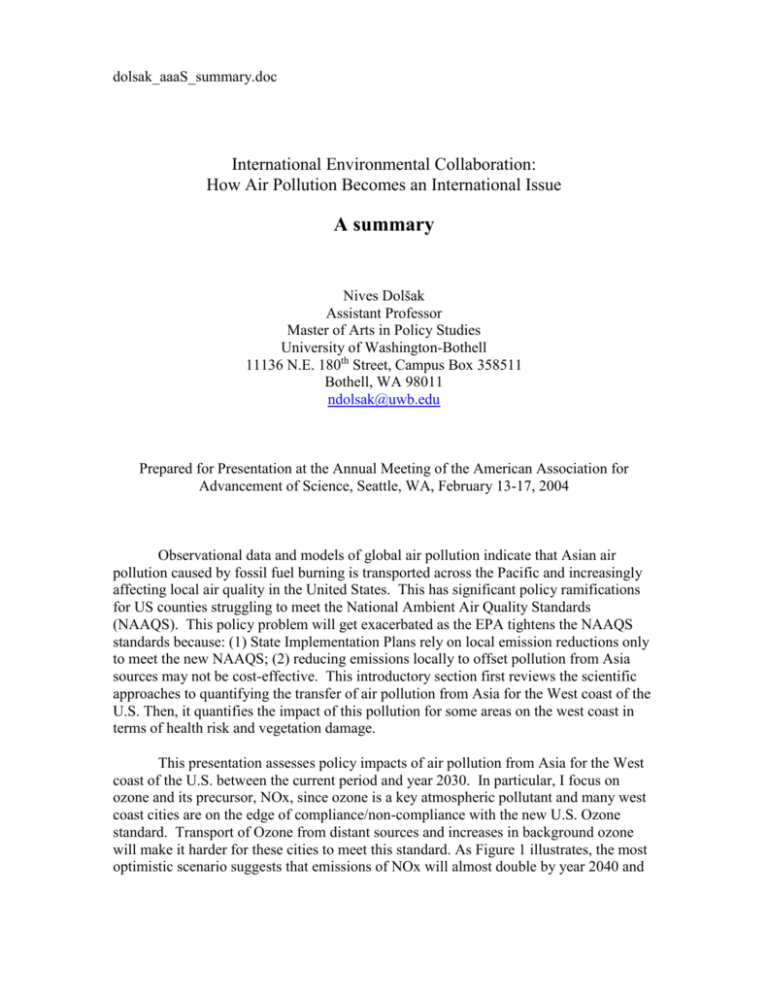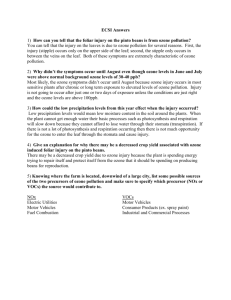Trans-Pacific Air Pollution and NAAQS Attainment
advertisement

dolsak_aaaS_summary.doc International Environmental Collaboration: How Air Pollution Becomes an International Issue A summary Nives Dolšak Assistant Professor Master of Arts in Policy Studies University of Washington-Bothell 11136 N.E. 180th Street, Campus Box 358511 Bothell, WA 98011 ndolsak@uwb.edu Prepared for Presentation at the Annual Meeting of the American Association for Advancement of Science, Seattle, WA, February 13-17, 2004 Observational data and models of global air pollution indicate that Asian air pollution caused by fossil fuel burning is transported across the Pacific and increasingly affecting local air quality in the United States. This has significant policy ramifications for US counties struggling to meet the National Ambient Air Quality Standards (NAAQS). This policy problem will get exacerbated as the EPA tightens the NAAQS standards because: (1) State Implementation Plans rely on local emission reductions only to meet the new NAAQS; (2) reducing emissions locally to offset pollution from Asia sources may not be cost-effective. This introductory section first reviews the scientific approaches to quantifying the transfer of air pollution from Asia for the West coast of the U.S. Then, it quantifies the impact of this pollution for some areas on the west coast in terms of health risk and vegetation damage. This presentation assesses policy impacts of air pollution from Asia for the West coast of the U.S. between the current period and year 2030. In particular, I focus on ozone and its precursor, NOx, since ozone is a key atmospheric pollutant and many west coast cities are on the edge of compliance/non-compliance with the new U.S. Ozone standard. Transport of Ozone from distant sources and increases in background ozone will make it harder for these cities to meet this standard. As Figure 1 illustrates, the most optimistic scenario suggests that emissions of NOx will almost double by year 2040 and then start declining. The most pessimistic scenario, however, suggests that emissions will increase almost threefold by year 2030 and almost fivefold by year 2050. Figure 1: Estimates of NOx Emissions from Asian Countries, Using IPCC Scenarios Source: Dolšak, Jaffe, and Jaegle, 2003. The Clean Air Act Amendments of 1970 mandated a federal agency--the Environmental Protection Agency (EPA)—regulate substances causing local air deterioration and set the maximum allowable concentration level for these pollutants. The EPA listed six major criteria pollutants whose excessive air emissions significantly impact human health and public wealth: ground ozone, carbon monoxide (CO), nitrogen oxides (NOx), sulfur dioxide (SO2), particulate matter (PM), and lead. The EPA and states subdivided the United States into Air Quality Control Regions, units responsible for air quality management. If the ambient quality in an area was worse than the standard set by the EPA, the area was designated as "non-attainment." This was not merely a declarative issue. Non-attainment areas faced severe development limitations, such as denial of permits for construction of new facilities, unless they improved their air quality. As a result of the various provisions in the Clean Air Act, air quality in the U.S. has improved significantly over the past thirty years. However, despite this, there still are some areas that continue to suffer from serious air pollution. In June of 2003, the EPA estimated that up 53 areas did not meet the 1-hour standards for ozone. As figure 2 illustrates, the major non-attainment areas for Ozone are located in the northeastern part of the U.S., California coast, Texas, and in the urban areas around the Great Lakes. 1 In 1997, the EPA revised its standards for Ozone and particular matter as a result of increasing information on significant health impacts of these pollutants are levels substantially lower than the current standard. The result was a proposal to transition from the 1-hour standard at the level of 0.12 ppm to the 8-hour standard at the level of 0.08 ppm. An area is in attainment of standard if a 3-year average of the 4th-highest concentration level is equal or less than 0.08 ppm (EPA, 1997). Using the 1999-2001 Ozone concentration data, the EPA estimated that 291 counties would not meet the new 8-hour Ozone standard. These estimates, however, fail to include a growing importance of the ozone precursors that are transported to the west coast of the U.S. The west coast of the U.S. is currently exhibiting varying levels of ozone pollution, from severe ozone problems in California, to modest levels of pollution and non-attainment in urban areas in Oregon and Washington. Background ozone levels along the west coast of the US are relatively high (30-50 ppbv). If this background increases, it may become more difficult for some regions to achieve US air quality standards. Given the scientific information about the transport of long-range ozone pollution from Asia to North America, the question arises as to whether any of the countries receiving ozone and acid rain pollution from China, i.e., Japan, Canada and the U.S. would try to internationalize this issue and push for emission reduction targets in China. The realist model of behavior of national governments is employed to hypothesize which sub-national actors and which national governments will most likely attempt to internationalize this environmental issue. The decision process of the national governments was examined at two levels, domestic negotiations with industry and environmentalists, and international negotiations among national governments. Three factors impacting these negotiations were reviewed: (1) the salience of environmental issue and the proportion of the problem that originates outside the national boundaries; (2) incentives of industries to internationalize the problem; and (3) presence of environmental NGOs. The examination of international power of the national governments potentially requiring internationalization of long-range ozone issue over the major emitter (China) was beyond the scope of this paper. The initial analysis suggests that among the countries receiving ozone pollution from China, Japan is most likely to push for internationalization of this issue for two reasons. First, its environment is most impacted by the pollution from China. If the example of Sweden in the creation of the CLRTAP is repeated, Japan is clearly going to be the international leader in this issue. Second, its industry is the leader in pollutioncontrol technologies and would, therefore, benefit most from internationalization. To better understand the role of the U.S. national government, we propose to study the role of States on the west coast of the U.S. in the formation of international environmental policy. Scientific data clearly suggests that the long-range ozone transport from Pacific causes the largest impact on the west coast, drops significantly after the Rocky Mountains and, then, gradually continues to drop across the U.S. This requires that the model of international environmental policy in federal countries include a study 2 of the impact of sub-national governmental units that extends beyond the clear industry lines, such as the influence of coal and oil producing States on the U.S. global climate change policy. 3






